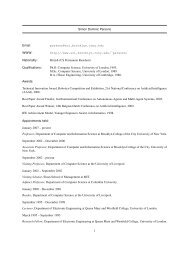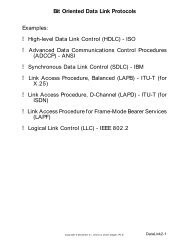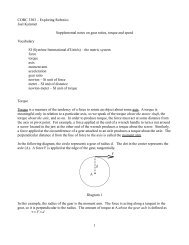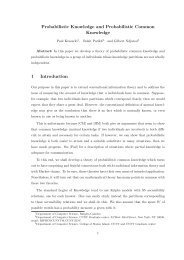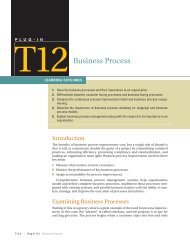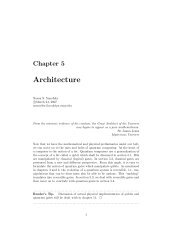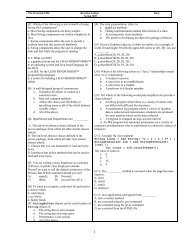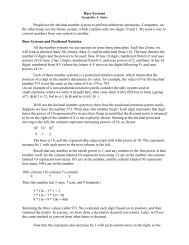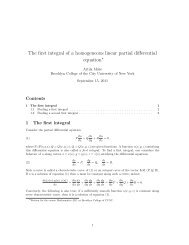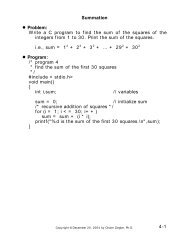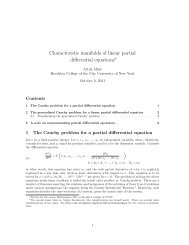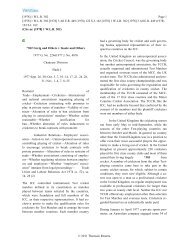Toward a Unified Theory of Human-Agent Modeling: A Position Paper
Toward a Unified Theory of Human-Agent Modeling: A Position Paper
Toward a Unified Theory of Human-Agent Modeling: A Position Paper
You also want an ePaper? Increase the reach of your titles
YUMPU automatically turns print PDFs into web optimized ePapers that Google loves.
(1a) modeling (1b) modeling (2) modeling<br />
representation outcomes <strong>of</strong> outcomes processes<br />
strategy individuals <strong>of</strong> groups<br />
symbolic SimEd, type IV [6] SimEd, type IV [7] MBTI, type IV [8]<br />
connectionist Tron, type III [9] Tron, type III [10]<br />
robotics, type III [11] SimEd, type II & III [2]<br />
Table 1. Categorization <strong>of</strong> approaches to human-agent modeling for projects discussed<br />
in this paper: SimEd (Sections 2 and 3); MBTI (§4); Tron (§2 and §3); robotics (§2).<br />
Our work has primarily focused on using connectionist strategies, though<br />
we have also explored symbolic strategies. Table 1 illustrates how some <strong>of</strong> our<br />
different projects, undertaken since 1997, fit within the categorization described<br />
above. The remainder <strong>of</strong> this paper highlights these examples; and we close with<br />
a brief discussion <strong>of</strong> ongoing and future work.<br />
2 <strong>Modeling</strong> the outcomes <strong>of</strong> individuals’ behaviors<br />
In 1997, we introduced a simple human-vs-agent video game inspired by the<br />
movie Tron and demonstrated one <strong>of</strong> the first Internet-based examples <strong>of</strong> collective<br />
intelligence [12]. In our Tron game, both players move continuously within<br />
a toroidal arena, each leaving an impenetrable trail marking its path (neither<br />
player can cross these trails). The trails do not decay, so eventually the arena fills<br />
up with “walls” and it becomes hard to find safe moves. The agent player has<br />
sensors that measure the distance to the nearest obstacles. Both players have a<br />
choice <strong>of</strong> 3 actions: turn left, turn right, or go straight. The goal is to maximize<br />
the length <strong>of</strong> an episode, by avoiding crashing into walls and staying “alive”<br />
longer than the other player. We trained agents, controlled by genetic programs,<br />
to play Tron by engaging in a co-evolutionary learning process that matched<br />
agents against humans. While this experiment did not model human behaviors<br />
directly, the game logs were mined in subsequent experiments, described next.<br />
Follow-on work [9] introduced the idea <strong>of</strong> using logs <strong>of</strong> humans’ actions, collected<br />
during the game play mentioned above, to train agent-based models <strong>of</strong><br />
the human players. These “trainees” were represented as neural networks with<br />
inputs corresponding to agents’ sensors and outputs corresponding to actions.<br />
The training process reconstructed previously-played games, following the moves<br />
<strong>of</strong> both players recorded in game logs. The human player is designated as the<br />
“trainer”, and the “trainee” network tries to replicate the human’s actions. Before<br />
each action taken by the human trainer, the current state <strong>of</strong> the game arena<br />
is input to the trainee agent’s network, which predicts which action to take.<br />
Then the prediction is compared to the trainer’s action recorded in the log. If<br />
the actions match, then the training sequence proceeds to the next move in the<br />
game. If the actions do not match, then the trainee’s network weights are adjusted<br />
(using back-propagation [13]), in proportion to the prediction error. This<br />
process continues until the trainee can predict its trainer’s actions with accuracy.



